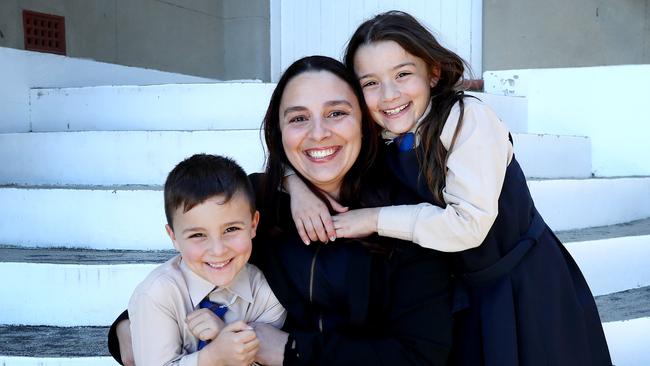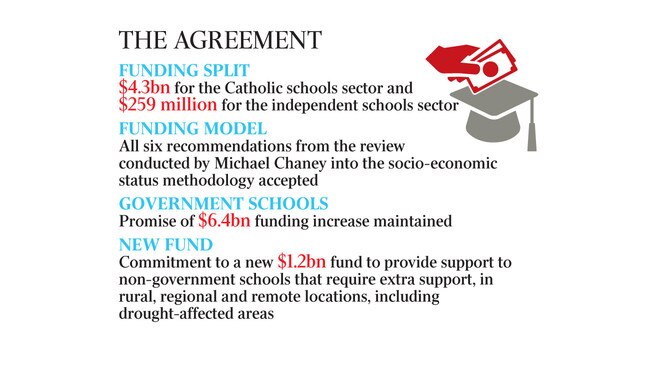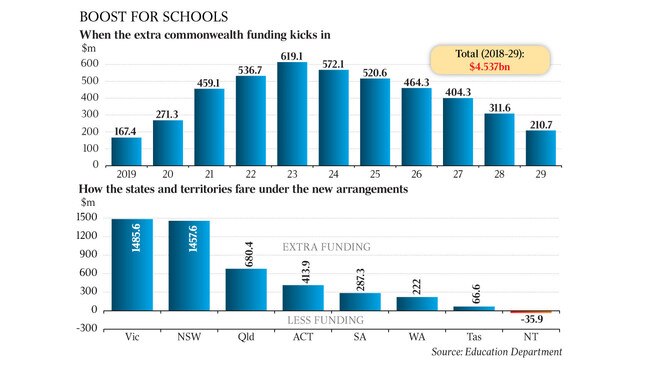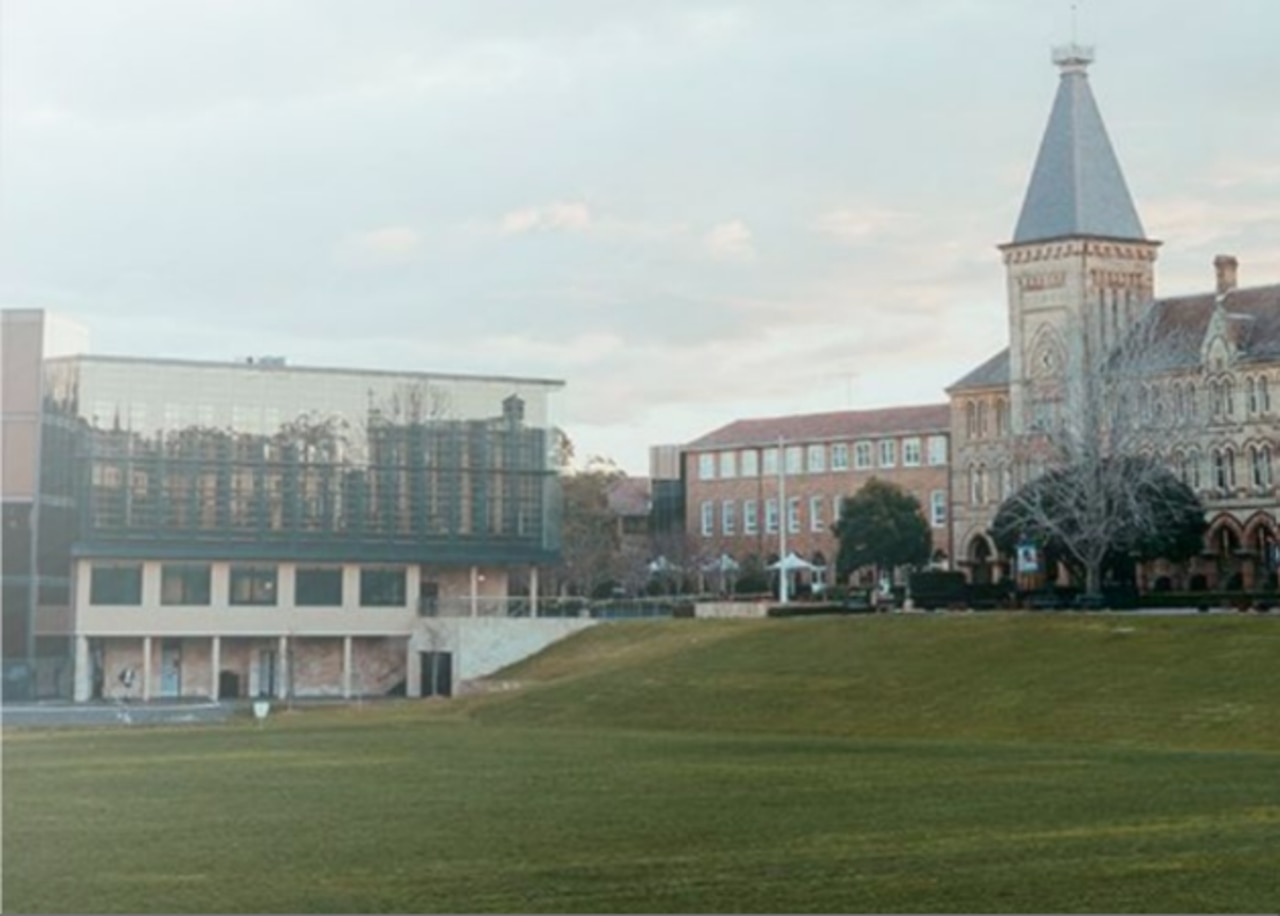School funding row ends with $4.5bn deal
As the PM defends the Catholic education funding package Matthias Cormann says it doesn’t need states’ support.

Scott Morrison has declared an end to the school funding war between the government and the Catholic education lobby, offering an extra $4.3 billion in funding increases for the sector over the next decade to avert the threat of 350 schools closing across the country.
After a year-long feud, a peace deal has finally been struck to restore the funding stripped from Catholic schools under the Turnbull government’s 2017 Gonski 2.0 school funding reforms.
A similar detente has been reached with independent schools, which will receive an extra $259 million under a total appeasement package for the non-government school sector of more than $4.5bn.
But Mr Morrison was this morning forced to defend the package against criticism from Liberal colleague, NSW Education Minister Rob Stokes, who said the new deal was unfair.
“We are the Gonski State,” the Mr Stokes said in a statement last night. “Quite simply, I won’t be signing any deal that doesn’t treat every student and every school with fairness.
“The Gonski principles provide that school funding should be needs based and sector blind and these are the principles we hold dear.
“We don’t want a return to the school funding wars of the past that pitted private schools against public schools, and urge the federal government to provide equal treatment for all schools, public and private.”
But Mr Morrison dismissed Mr Stokes’ attack, claiming his fellow Liberal has not yet “had the chance to really look at the full details”.
“I don’t think Rob’s yet had the chance to really look at the full details of this, and there’ll be an opportunity for that today, and I’m sure once he sees that he’ll see that those comments don’t weigh up with what we’ve actually announced,” Mr Morrison told ABC this morning.
“I’ve had exchanges this morning with the Premier (Gladys Berejiklian). We’ve had a few text exchanges this morning.
“I don’t think Rob has the full details and the full understanding of what the package is.”
Finance Minister Mathias Cormann said the federal government does not require the support of the states to increase funding to the Catholic and independent schools sector.
“Firstly the states don’t have to sign on to the agreement that the Commonwealth reaches with the non-government schools sector,” he told Sky News this morning. “And secondly, once he’s had a chance to look through the detail we’re confident that he’ll be reassured what we are proposing is fair and equitable.
“Funding for state government schools is increasing strongly over the next decade, 6.3 per cent per year on average - much stronger than the funding increases, incidentally, into the non-government schools.
Asked about Mr Stokes’ objections to the extra $1.2bn “choice and affordability fund”, Senator Cormann said the government would be providing about $310bn in funding to all schools over the same decade-long period.
“When you consider that there’s federal funding to all schools of about $310bn, I think you can put the decisions that we’ve made this week into a better perspective,” he said.
Asked whether the total $4.6bn funding package was money that would no longer go towards paying off government debt, Senator Cormann said the government was making “significant progress” in paying off “the debt trajectory that Labor has left behind”.
“I mean over the current forward estimates, we are projected to reduce government net debt by $30bn, over the next decade by $232bn,” the Finance Minister said.
Asked whether the $4.6bn would reduce the $232bn figure, Senator Cormann said all of the budget numbers would be updated in MYEFO.
“There’s obviously always a range of movements up and down,” he said.
“We’ll be providing a final budget outcome for 2017-18 next week, the Treasurer and I, and you will see how the government has been tracking in terms of actual performance against budgets, but you know there’s always a range of movements up and down and all of that will be reconciled in the midyear budget update before Christmas.”
The issue of school funding was expected to be a key sticking point at next month’s COAG meeting, but Mr Morrison this week postponed that meeting until later in the year.
A senior government source said last night that the Prime Minister had headed off a potential election crisis for the Coalition, as the Catholic schools sector had been threatening to mobilise parents of more than 800,000 students across the country.
The tripartite agreement was struck at lunchtime yesterday by Education Minister Dan Tehan and announced an hour later. It will deliver a $1.1bn hit to the budget over the four-year forward estimates but would likely be covered through upwardly revised budget revenue estimates in the mid-year budget review in December.
Mr Morrison yesterday acknowledged that it was a dispute that had to be brought to an end, claiming it as a victory for the principle of parental choice.

“This is an important issue the government has been working on for some time and it’s been a keen area of focus of our government over the last three to four weeks,” he said. “Our government believes that parents should have choice in education. This has been a fundamental belief of the Liberal and the National parties for a very long time.”
In the days preceding the leadership spill, Malcolm Turnbull was proposing an offer of a $3.8bn increase, according to the Catholic school sector, and was close to reaching agreement.
The package delivered by Mr Tehan is believed to have resolved a fundamental sticking point around an extra “parental choice” fund to prevent low-fee Catholic primary schools having to hike fees and potentially lose students from low-income households.
The overall package, which will require regulation rather than amendments to the Australian Education Act, comprises changes to the school-funding model plus the creation of a new fund. The changes to the school funding model will see a total of $3.2bn in extra funding increases between next year and 2029 for non-government schools.
The funding increase for Catholic schools is larger than this, but is slightly offset by a reduction in funding for independent schools.
Mr Morrison said the government would also provide $1.2bn between 2020 and 2029 for the new fund to support “parental choice and diversity in the school system”. It would be used to support non-government schools in regional, rural and remote areas.
Mr Tehan confirmed that of the total $4.5bn in extra funding, $4.3bn would go to the Catholic school sector, whose claims had originally been dismissed by the government but were later vindicated.

Catholic Education Commission of Victoria executive director Stephen Elder, who led the campaign for the sector, said Mr Tehan had “genuinely listened to the concerns of Catholic education, recognised that there are major flaws in the funding model and acted decisively to address them”.
“Catholic schools faced massive fee increases or closures under the flawed funding model legislated by the Turnbull government in 2017,” Mr Elder said.
Sydney Catholic Archbishop Anthony Fisher, chairman of the Bishops Commission for Catholic Education, welcomed the deal, claiming it was an “equitable outcome” for students and families.
“Educational need cannot be limited to financial need,” Archbishop Fisher said. “Every child needs a quality education and there is a need for every parent to have a real choice in education, including the option of a faith-based school. The previous funding arrangements put in jeopardy the future of low-fee, low-expenditure, faith-based schools.”
The Independent Schools Council of Australia congratulated the government, claiming the deal was a “reasonable” resolution to the funding issues.
“The extension of 2018 funding arrangements to 2019 by Minister Tehan provides immediate certainty for schools planning for the new year, while allowing time for further work to be undertaken on the complex technical issues involved in implementing the new methodology,” the ISCA said.
A review of the socio-economic status system — commissioned by former education minister Simon Birmingham following the announcement of the Gonski 2.0 reform package in May last year, and conducted by businessman Michael Chaney — found that the SES model on which Gonski 2.0 was based was flawed. It relied on geographic socio-economic status as the basis for needs-based funding, assuming all parents were of a similar wealth and had equal capacity to contribute.
The review found the Catholic sector faced almost $2bn in funding cuts under Senator Birmingham’s reforms, providing the catalyst for the dispute between the sector and the government.
The Chaney review recommended a new system, which the government will adopt, using the taxable income of parents as a basis for funding need.
The government will extend the transition period for overfunded independent schools to shift down to 80 per cent of their Commonwealth Schools Resources Standard to 2029.
The overall package will increase the commonwealth government’s funding commitment to the non-government school sector from 76 per cent of the School Resourcing Standard to 80 per cent. The commonwealth will maintain its promise of a $6.4bn funding increase to government schools.
Opposition education spokeswoman Tanya Plibersek said the new funding model still amounted to across-the-board cuts. “It is not a better deal, it is an interim arrangement,” she said.
Lisa Maletta, whose children attend St Fiacre Catholic Primary School in Leichhardt in Sydney’s inner west, said the resolution would “make it affordable for us to have a Catholic education for our children. I think all kids deserve a good education and families should have the opportunity to choose what they want for their children.”
Labor education spokeswoman Tanya Plibersek said it was “completely unacceptable” for the government to restore funding to Catholic and independent schools but continue to impose a “$14bn cut” on state schools over the next decade.
“They’ve finally confessed to the fact that they’ve cut billions of dollars despite saying all this time there have been no cuts,” Ms Plibersek told ABC radio.
“There’s 2.5 million students in public schools around Australia. Two out of three of all Australian students go to public schools, and public schools teach 84 per cent of indigenous kids, 74 per cent of children with a disability, 82 per cent of children in the bottom income group, and those schools are being told that they don’t get a dollar extra from this government.
“Now when the current NSW Liberal Education Minister says it’s unfair, the previous Coalition education minister from NSW Adrian Piccoli says it’s unfair, the Grattan Institute and other organisations that follow school funding very closely say it’s unfair, you’ve got to listen to that.”
Mr Piccoli yesterday labelled the deal “pathetic” and accused the government of “throwing money at the powerful and well-connected”.
Ms Plibersek said Mr Morrison could not explain how the extra $1.2bn fund would be distributed.
“Are there no public schools in drought stricken areas? Is that really his contention?” she said.
“He calls this a sector-blind fund, but public schools aren’t allowed to apply.
“Is he really saying there are no drought-stricken public schools that would benefit from extra funding, that could help their kids with social and emotional wellbeing programs at a time of incredible hardship for them and their families?”
As the system currently operates, the commonwealth is responsible for 80 per cent of the government funding received by Catholic and independent schools, and 20 per cent of state school funding, with the states and territories making up the difference.
Ms Plibersek said it was clear some states and territories needed more from the commonwealth than others.
“What we say is that every school, over time, should get to 100 per cent of the schooling resource standard, and we need to do that together with the states and territories,” she said.
“Are we really saying that the Northern Territory has the same ability to fund its schools as New South Wales or Victoria? Of course it doesn’t, and that’s where the most disadvantaged children are.
“They’re the kids with the greatest educational needs. They’re in some cases years behind their peers in the southern states, and we’re saying ‘too bad, tough luck, you’re on your own,’ to those kids.”
Labor MP Anthony Albanese also seized on Mr Stokes’ claim the new funding package was pitting the Catholic sector against public schools this morning.
“What he’s done, according to NSW Liberal government, is recreate the education wars.” he told 9. “Here we have this massive injection of cash, but only to Catholic and independent schools.”
“Public schools, where most kids go in Australia, are missing out, it’s changing again moving away from the formula, and he should look after all children, not just some.”
Additional reporting: Rachel Baxendale




